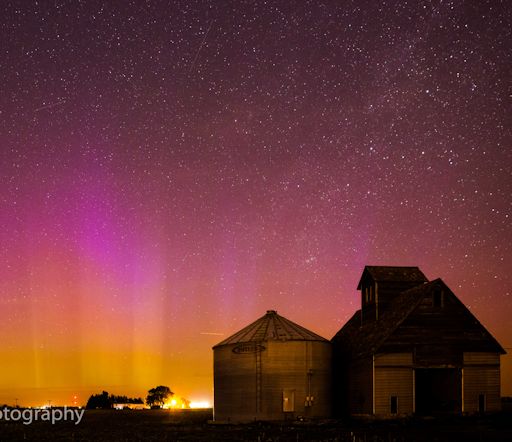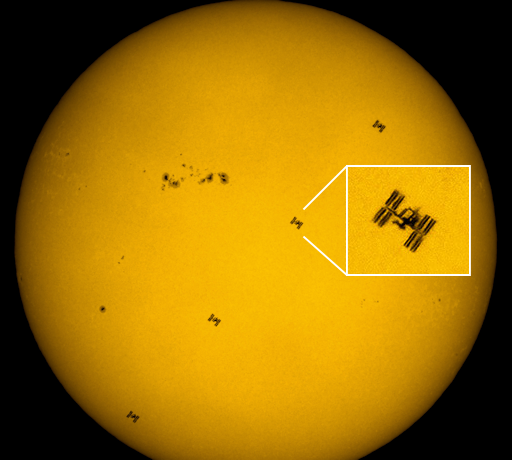Learn to photograph Northern Lights like a pro. Sign up for Peter Rosen's Aurora Photo Courses in Abisko National Park. | | | SEA SALT ON EUROPA: For decades, researchers have wondered about the sinuous dark marks on Jupiter's moon Europa. What are they? A new study by NASA provides an answer: It is sea salt. Somehow, salt from Europa's underground ocean is making its way to the moon's surface. There it is darkened by strong "space weathering" from Jupiter's stormy magnetosphere. Read all about it. GEOMAGNETIC STORM: A high-speed stream solar wind is buffeting Earth's magnetic field, and this is causing geomagnetic storms around the poles. Last night during a G2-class disturbance, Northern Lights spilled across the Canadian border into several US states. Brad Dwight took this picture from the countryside near Modale, Iowa: 
"There was a sudden outburst at 3am," says Dwight. "A 15 second exposure with my Canon 5DII digital camera captured the pink and yellow rays." More auroras are in the offing. NOAA forecasters estimate a 60% chance of geomagnetic storms on May 13th as the solar wind continues to blow. Observing tip: The best time to look is usually during the hours around local midnight. Aurora alerts: text, voice Realtime Aurora Photo Gallery SPACE STATION TRANSIT: On May 12th, the sunspot number increased--but only for a split-second--when a winged silhouette flew across the solar disk. Levin Dieterle of Reutin (Alpirsbach), Germany, captured the the transit: 
It was the International Space Station. "I took the pictures using a Canon EOS 5D MKIII digital camera looking through a 6-inch refracting telescope--solar filtered, of course!" says Dieterle. Calsky provided the transit prediction. So far this week, space station transits have been the chief form of activity on the quiet sun. No significant solar flares have been observed despite the fact that behemoth sunspot AR2339, shown above alongside the ISS, has an unstable 'beta-gamma' magnetic field. The sunspot may yet produce its own contribution: NOAA forecasters estimate a 30% chance of M-flares and a 5% chance of X-flares on May 13th. Solar flare alerts: text, voice Realtime Space Weather Photo Gallery
Realtime Comet Photo Gallery
Every night, a network of NASA all-sky cameras scans the skies above the United States for meteoritic fireballs. Automated software maintained by NASA's Meteoroid Environment Office calculates their orbits, velocity, penetration depth in Earth's atmosphere and many other characteristics. Daily results are presented here on Spaceweather.com. On May. 13, 2015, the network reported 10 fireballs.
(8 sporadics, 1 eta Lyrid, 1 eta Aquariid)  In this diagram of the inner solar system, all of the fireball orbits intersect at a single point--Earth. The orbits are color-coded by velocity, from slow (red) to fast (blue). [Larger image] [movies] Potentially Hazardous Asteroids ( PHAs) are space rocks larger than approximately 100m that can come closer to Earth than 0.05 AU. None of the known PHAs is on a collision course with our planet, although astronomers are finding new ones all the time. On May 13, 2015 there were potentially hazardous asteroids. Notes: LD means "Lunar Distance." 1 LD = 384,401 km, the distance between Earth and the Moon. 1 LD also equals 0.00256 AU. MAG is the visual magnitude of the asteroid on the date of closest approach. | | The official U.S. government space weather bureau | | | The first place to look for information about sundogs, pillars, rainbows and related phenomena. | | | Researchers call it a "Hubble for the sun." SDO is the most advanced solar observatory ever. | | | 3D views of the sun from NASA's Solar and Terrestrial Relations Observatory | | | Realtime and archival images of the Sun from SOHO. | | | from the NOAA Space Environment Center | | | the underlying science of space weather | | 
